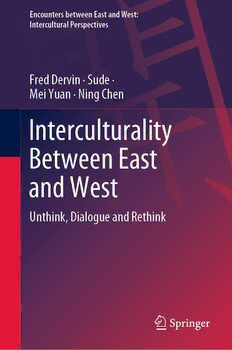
Interculturality Between East and West: Unthink, Dialogue and Rethink PDF
Preview Interculturality Between East and West: Unthink, Dialogue and Rethink
Encounters between East and West: Intercultural Perspectives Fred Dervin · Sude · Mei Yuan · Ning Chen Interculturality Between East and West Unthink, Dialogue and Rethink Encounters between East and West Intercultural Perspectives SeriesEditor FredDervin,TheUniversityofHelsinki,Helsinki,Finland AbouttheSeries This book series publishes volumes problematizing the issue of East versus West. Thetopicscoveredintheseriesrepresentpast,currentandfuturetrendsinintercul- tural encounters and communication between the East and West, including: - The role of language in such encounters, for example plurilingualism and English as a global language. - The impact of digital technologies in East/West interactions. - TheconstructionoftheEast/Westindifferentkindsofdiscourses,suchasinmedia, fiction,educationalproductsandservices,marketingandtourism.-Diachronicexam- inationsofencountersbetweentheEast/West.-Theimpactofmobility/migration. - Comparison of different but similar populations in the East/West (e.g. migrants, teachers,etc.).-RedefinitionsoftheEast/West,intermsofchangingfrontiers,polit- ical terms. The series also demonstrates innovative ways of conducting intercul- turalresearch.Ithasnowbecomeaclichétosaythatinterculturalencountershave increased over recent decades. Interculturality is not new – far from it! Encoun- tersbetweenpeoplefromdifferentbackgroundsspeakingdifferentlanguageshave alwaystakenplace,butthedifferencetodayisthespeedandeasewithwhichthey occur. Research on interculturality and intercultural communication dates back to the 1950s with different paradigms emerging over the years. However, we have nowreachedamaturestageofscientificdevelopmentanddiscussionsonthistopic. While initially a simple understanding of ‘national culture’ was used to explain what happened when people fromdifferent countries met, today analyses of inter- culturality are more complex and also take into account elements such as gender, religion, social class and age. The last decade has seen major changes in the way interculturalityisstudied,withashiftfromanoveremphasisonculturetoafocuson identity. Global politics has also changed since the 1950s and some countries that usedtobecoloniesor‘closed’societieshave(re-)emergedandinsomecasestaken oneconomic,politicalandsymbolicpositions.ThedichotomyoftheEastvs.West has also reappeared after the collapse of the Soviet Union. This largely imaginary andpoliticalcharacterizationofourworldnowdeservesmoreattention,especiallyin relationtointerculturalencountersandcommunicationbetweenthesetwospheres. Moreinformationaboutthisseriesathttps://link.springer.com/bookseries/13823 · · · Fred Dervin Sude Mei Yuan Ning Chen Interculturality Between East and West Unthink, Dialogue and Rethink FredDervin Sude DepartmentofTeacherEducation MinzuUniversityofChina UniversityofHelsinki Beijing,China Helsinki,Finland NingChen MeiYuan TianjinAcademyofFineArts MinzuUniversityofChina Tianjin,China Beijing,China UniversityofHelsinki Helsinki,Finland ISSN2364-6721 ISSN2364-673X (electronic) EncountersbetweenEastandWest ISBN978-981-16-8491-3 ISBN978-981-16-8492-0 (eBook) https://doi.org/10.1007/978-981-16-8492-0 ©TheEditor(s)(ifapplicable)andTheAuthor(s),underexclusivelicensetoSpringerNature SingaporePteLtd.2022 Thisworkissubjecttocopyright.AllrightsaresolelyandexclusivelylicensedbythePublisher,whether thewholeorpartofthematerialisconcerned,specificallytherightsoftranslation,reprinting,reuse ofillustrations,recitation,broadcasting,reproductiononmicrofilmsorinanyotherphysicalway,and transmissionorinformationstorageandretrieval,electronicadaptation,computersoftware,orbysimilar ordissimilarmethodologynowknownorhereafterdeveloped. Theuseofgeneraldescriptivenames,registerednames,trademarks,servicemarks,etc.inthispublication doesnotimply,evenintheabsenceofaspecificstatement,thatsuchnamesareexemptfromtherelevant protectivelawsandregulationsandthereforefreeforgeneraluse. Thepublisher,theauthorsandtheeditorsaresafetoassumethattheadviceandinformationinthisbook arebelievedtobetrueandaccurateatthedateofpublication.Neitherthepublishernortheauthorsor theeditorsgiveawarranty,expressedorimplied,withrespecttothematerialcontainedhereinorforany errorsoromissionsthatmayhavebeenmade.Thepublisherremainsneutralwithregardtojurisdictional claimsinpublishedmapsandinstitutionalaffiliations. ThisSpringerimprintispublishedbytheregisteredcompanySpringerNatureSingaporePteLtd. The registered company address is: 152 Beach Road, #21-01/04 Gateway East, Singapore 189721, Singapore Acknowledgements TheauthorswouldliketothankthestudentsfromtheSchoolofEducationatMinzu UniversityofChinawhohaveunthought,rethoughtanddialoguedwiththemfora coupleofyearsnow.GratitudeisalsoduetoYuyinLiangandXiaowenTianfortheir precioushelp. 谢谢妈妈可口的饭菜,辛苦了. v Praise for Interculturality Between East and West “The authors have been thinking, questioning, and arguing about interculturality throughoutthisbook.Iadmiretheirbraveryandresilience.Thisbookwillprompt furtherthinking,debateandwiderreflectiontowardsadeeperunderstandingofinter- culturality. Challenge the authors and yourself while reading as they challenged themselveswhilewriting!” —LixianJin,ChairprofessorofAppliedLinguistics,DeanofFacultyof HumanitiesandSocialSciences,CityUniversityofMacau “Thepandemiccrisis,whichbrokeoutin2020,hascausedunprecedentedtransfor- mationsforusall.Ineducationandresearch,thecrisishassenttheurgentmessagethat thereisaneedtoshakethingsupinthewaywecommunicatewitheachotheracross national borders. In this book the authors conceptualize afresh the contentious but stimulatingnotionofinterculturality,beyondthecanon.Unthinking,dialoguingand rethinkingtogether,andwiththeirstudents,theauthorsmanagetoprovidesomeof themostmeaningfulinsightsontheimportanceoflisteningtootherwaysof‘doing’ interculturality. Interculturality Between East and West deserves a wide audience from educators to the global academic community in the many and varied fields relatedtointerculturality.” —ZhongyingShi,Dean,Professorofeducation,InstituteofEducation, TsinghuaUniversity,China “InterculturalityBetweenEastandWest beginswithaninvitationtosearchfor‘the pearl’—throughunthinking,dialoguingandrethinkingourunderstandingsofinter- culturality. The global orchestra of research and practice in the field easily gets dominated by a few ‘loud’ voices and interpretations of interculturalism, falsely believingthatthesewouldapplyinasimilarwayaroundtheworldorevenbeshared bythosenextdoor.Wheninfact,aswelearnfromthebook,thetraditionalmeaning fortheChinesewordforculturereferredtothechangehappeningtopeoplethrough theirencounterswitheachother.Understandinginterculturalitythisway,aschange occurring to and between people who meet each other, the emphasis shifts from vii viii PraiseforInterculturalityBetweenEastandWest the dominance of the few to the opportunities of everyone for reciprocal learning in dialogue. This is what the authors invite us into, through the volume: to work togethertostimulatearadicalcapacitytorethinkinterculturality.” —ArniikaKuusisto,ProfessorofChildandYouthStudies,StockholmUniversity, Sweden “Interculturality Between East and West is one of few truly intercultural books. Dervin,Sude,YuanandChendonotjustrecountajuxtapositionofdifferentideas andviewpoints.Instead,theypresentaninteractionofdifferentperspectivesthatis based on thinking, talking and listening among diverse scholars, practitioners and students.Nowadays,theconceptof‘interculturality’becameanewpopulism,thatis dominatedby‘Western’waysofthinking.Consideringtheterminologicalconfusion andmisunderstandingsacrosstheworldandacrossdisciplines(andalsothemany creative related concepts and terms that have been invented in recent years), there isanurgentnecessitytodevelopasharedterminology,groundedinepistemological bases.Thisbookoffersreaderstheopportunityto‘listentoChina’,toengagewith her,tostartadialoguewithheraround‘interculturality’.Ifreadersarereadytogo beyond stereotypes and prejudices, they will discover many unknown paths. They willnotlearnanorthodoxnormativescaffoldingrelatedtotheterm‘interculturality’. Instead,bylisteningtodifferent‘musicians’,thebookdeliverspreciousopportunities for developing perplexity, modesty and generosity—fundamental steps for finding sharedmeaningsandterminology.” —AgostinoPortera,Professorofinterculturaleducation,UniversityofVerona, Italy “Thisbookrepresentsanimportantcontributiontoresearchonlanguageandinter- cultural education, genuinely building bridges between the ‘East’ and the ‘West’. Interculturalityisaneminentlycomplexnotionthatcallsformethodsofanalysisthat appealtotheparadigmsofthepluri- andthemulti- (inshort:toadynamicwhole). BuildinguponDervin,Sude,YuanandChen’salreadywell-establishedresearch,the book manages to provide a convincing approach to the inter- by defeating binary, comparative, and explanatory attempts to oppose the East and the West. Written dialogically,thebookoffersoriginalperspectivesanchoredintheauthors’andtheir students’ experiences and reflections. In the chapters, the authors confront many stereotypes and ‘blow them up’ by subjecting interculturality to precise analyses. Theyalsorenewandactualizethegazeona‘notioninmotion’thatrequiresconstant reconfiguration,hencethecentralityofthetopicofidentitiesinthebook.Theclose tiesbetweeninterculturalityandlanguagesarealsorightlyremembered.Allinall, theauthorsdonotdescribeinterculturalityinordertounderstand and/orexplainit. Rather,throughtheirmultifaceteddialogues,theywanttocaptureitinitseye-opening diversity,beyondtheproblematicbinaryofEastandWest.” —Prof.DominiqueMacaire,UniversityofLorraine,France PraiseforInterculturalityBetweenEastandWest ix “IapplaudDervin,Sude,Yuan,andChen’sInterculturalityBetweenEastandWestfor takingonthechallengeoftacklingadeep-rootedprobleminthefieldofintercultural studies—awide-spreadmisunderstandingthatinterculturalitymeansthesameand is ‘done’ the same way around the world. It is time to listen to lessons learned fromthedialoguesbetweentheauthorfromtheWestandtheauthorsfromtheEast and from the dialogues with their students in China. I have been teaching about interculturality in intercultural communication and intercultural education classes for nearly two decades on several continents, including Asia. A book that would addressinterculturalityfromtheEastAsian,Chineseinparticular,perspective has beenonmywishlistforalongtime.Thisbookfillsagapinmultiplefieldsofresearch andeducationrelatedtointerculturality.AsChinaisbecomingmoreengagedwith therestoftheworld,thisvolumeisamustread.” —Dr.PhyllisBo-yuenNgai,UniversityofMontana,USA “Dervin,Sude,YuanandChenhaveputtogetherabookthatprovidesurgentlyneeded contributionsandcorrectionstohegemonicglobaldiscoursesoninterculturalityin several ways. Even though our globalized world attaches great importance to the phenomenon of interculturality, yet the term is still often misunderstood and does moreharmthangood.Thepointistoradicallydecolonizeandde-centeraformerly Western concept. The authors do not understand this task as a mere call to our consciousness,buttheyequallypracticeandlivethisde-centeringanddecoloniza- tionintheirbook.Interculturalityhereischallengedonthelevelsoftheory-building, developing research methods as well as ethical considerations. Not to forget that from a Western point of view, China is still a prototypical bluescreen for cultur- aliststereotyping.Readersthusgainvividinsightsintothemultifacetednatureand complexityofwhatcanbeunderstoodbyinterculturalityworldwide.Interculturality BetweenEastandWest illustratestheextenttowhichweneedtomoveawayfrom oldpatternsofthinkinginresearcharoundinterculturality.Dervin,Sude,Yuanand Chenhavesucceededhereinproducingaveryuniquebookwhichactuallyshould setanewstandard.” —Prof.DominicBusch,BundeswehrUniversityMunich,Germany Contents 1 Introduction .................................................. 1 1.1 LookingforaSpecialPearl ................................ 1 1.2 WorkingMethod:Multidialogues ........................... 3 1.3 Dialogueswith‘China’ ................................... 5 1.4 BookStructure ........................................... 8 References .................................................... 9 2 TheIdeaofCultureIsWornOut ............................... 11 2.1 Introduction ............................................. 11 2.2 ‘Culture’inaChineseBookstore ........................... 14 2.3 WhattoDowithThisConceptofCultureThen? .............. 18 2.4 [TimetoReflect] ......................................... 21 References .................................................... 22 3 ‘Killing’or‘Curing’Culture? .................................. 25 3.1 ShortRecap ............................................. 25 3.2 Again:WhattoDowith‘Culture’Then? ..................... 27 3.3 CultureandTaste ......................................... 29 3.4 OntheNeedto‘DispeltheFamiliarityoftheAccepted’ (Foucault) ............................................... 30 3.5 FiveProblemsAboutCulture .............................. 31 3.6 [TimetoReflect] ......................................... 37 References .................................................... 39 4 LanguageIsNotWhatWeMightThinkItIs—Facilitating InterculturalitybyUnthinkingandRethinkingOurRelation toLanguage .................................................. 41 4.1 MultilingualEtymology ................................... 41 4.2 DemystifyingLanguage ................................... 43 4.3 NoNeedtobe‘Perfect’inaLanguagetoCommunicate withOthers .............................................. 52 4.4 [TimetoReflect] ......................................... 54 xi
